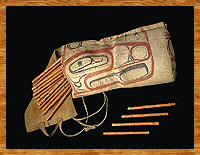 |
The Haida had several popular games that involved gambling, and a lull in any social activity was a good reason to play. One was a simple game similar to "pickup sticks". The thin playing sticks were quickly made and never decorated, so they were not sought by collectors and no examples are preserved in museums.
Another game consisted of three sets of sticks, named after different animals or birds, which, according to Charles F. Newcombe, were known only to the owner and his family. The sticks have rings and spiral markings to distinguish them, but the most elaborate sets are a veritable gallery of Haida art and may contain fifty or more unique drawings. The sticks were made of hard maple and were decorated by carving, painting and pyro-engraving with a hot poker; many were inlaid with abalone shell or copper. The burning-in of designs with a hot poker demanded different skills from Haida artists, who responded admirably to the challenge. The drawings are difficult to appreciate at first glance, since they are wrapped completely around the sticks, which must be rotated slowly to unlock their form. Some have jumping shaman figures that resemble an animated cartoon; as the stick is rotated, one shaman after another jumps into view. Flying birds are also common, along with jumping killer whales.

 |
A set of Haida gambling sticks decorated with pyro-engraved crest images. They were kept in the painted deerskin bag.
Collected at the Nass River village of Gitlaxdimiks in 1905 by Charles F. Newcombe.
CMC VII-C-142 (S92-4313) |

There are also scores of examples of very complex scenes such as war parties in canoes, seal otter hunters in action, or fishermen and their catch -- each entire composition no more than 2 cm ( ¾ inch) in length. These gaming pieces seem to offer the only decorative field in which the Haida artist felt free to become truly documentary. Drawings of half a dozen sets of these decorated sticks have been published by Franz Boas, Swanton and others, but many await study. George T. Emmons recorded in meticulous detail the identifications by a Tlingit owner of a full set of sticks now in the National Museum of the American Indian.
These gambling sticks were used on a special leather mat that was often decorated with painted or pyro-engraved images that appear to be regular crests. This is appropriate, since crests are generally considered to bring good fortune to those who have the inherited the right to use them.
|